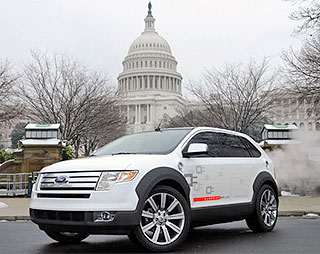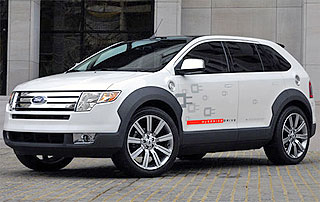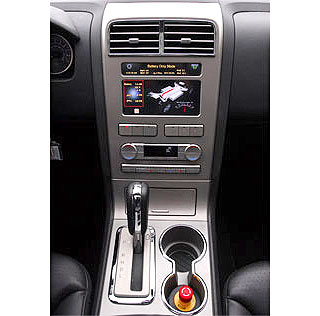

 The Volt may have been the darling of the recent 2007 North American International Auto Show, but it is not yet ready for the street. Ford showcased the Edge prototype by taking the media and lawmakers on brief test drives in advance of this week's Washington auto show and on the eve of President Bush's State of the Union address, which is expected to urge action on biofuels, hybrids and better fuel economy.
The Volt may have been the darling of the recent 2007 North American International Auto Show, but it is not yet ready for the street. Ford showcased the Edge prototype by taking the media and lawmakers on brief test drives in advance of this week's Washington auto show and on the eve of President Bush's State of the Union address, which is expected to urge action on biofuels, hybrids and better fuel economy.Ford was careful to emphasize that "many significant technical hurdles need to be overcome" before the Edge with HySeries Drive becomes a reality. The automaker said that the single biggest hurdle to plug-ins remains the cost of lithium-ion batteries.
The Edge with HySeries Drive uses what Ford calls a "real-world version" of the power plant envisioned in the Ford Airstream concept that was unveiled earlier this month at the Detroit auto show. The name is derived from the powertrain's structure: a hydrogen fuel-cell-powered series hybrid powertrain.
The Edge prototype weighs 5,400 pounds, over 1,000 pounds more than a conventional Edge. It has five basic parts: a fuel cell, a hydrogen tank, two electric motors and a lithium-ion battery pack.
With its batteries fully charged, the Edge prototype can go about 25 miles on electricity alone. Once the batteries discharge about 60 percent, the fuel cell switches on to power the electric motors and recharge the battery pack, giving the vehicle another 200 miles of range.
Ford says the HySeries Drive powertrain delivers a combined city/highway gas equivalent fuel economy rating of 41 mpg. For those who drive fewer than 50 miles per day, the average jumps to the equivalent of more than 80 mpg.
© Source: article on insideline











No comments:
Post a Comment